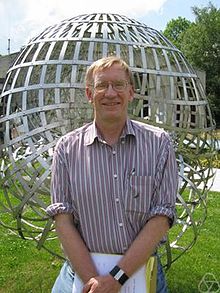- Gunnar Carlsson
-
Gunnar Carlsson (* 22. August 1952 in Stockholm) ist ein schwedischer Mathematiker, der sich mit algebraischer Topologie beschäftigt.
Inhaltsverzeichnis
Leben und Wirken
Carlsson studierte an der Harvard University (Bachelor-Abschluss 1973) und promovierte 1976 an der Stanford University bei R. James Milgram (Operations in Connective K-Theory and Associated Cohomology Theories). Ab 1976 war er Leonard Dickson Instructor an der University of Chicago und ab 1978 zunächst Assistant Professor, ab 1981 Associate Professor und ab 1983 Professor an der University of California, San Diego. 1986 bis 1991 war er Professor an der Princeton University und ab 1991 an der Stanford University. Er war 1989 und 2006 Gastwissenschaftler am MSRI in Berkeley.
Carlsson bewies Mitte der 1980er Jahre die verallgemeinerte Sullivan-Vermutung, unabhängig von Jean Lannes und Haynes Miller. Er beschäftigte sich auch mit algebraischer K-Theorie und topologischen Untersuchungen hochdimensionaler Daten-Mannigfaltigkeiten [1] beispielsweise in der Gestalterkennung sowie mit Mathematikdidaktik.
1983 bis 1987 war er Sloan Fellow. 1988 bis 1998 war er Mitherausgeber der Mathematischen Zeitschrift.
Schriften
- mit Ralph L. Cohen: The What, Where and Why of Mathematics. A handbook for Teachers. 1991.
- mit Ralph L. Cohen: Topics in Algebra. 1999.
- mit Carne Barnett-Clarke, Debra Coggins, Bill Honig, Drew Kraven: A mathematics source book for elementary and middle school teachers. Key concepts, teaching concepts and learning pitfalls. Bay Area Mathematics Task Force Report.
Weblinks
Einzelnachweise
- ↑ siehe Ghrist Bar Codes - the persistent topology of data, Bulletin AMS, Bd.45, 2008, S.61, Online, Carlsson Topology and Data, Bulletin AMS, 2009
Wikimedia Foundation.

